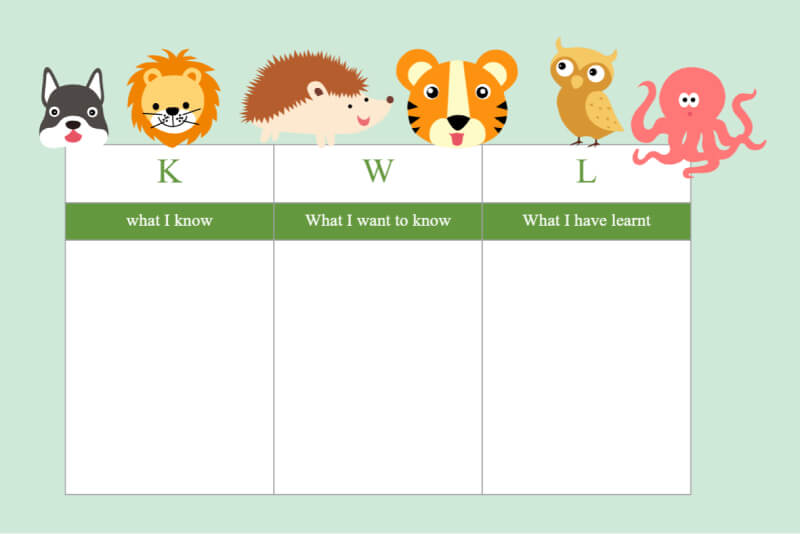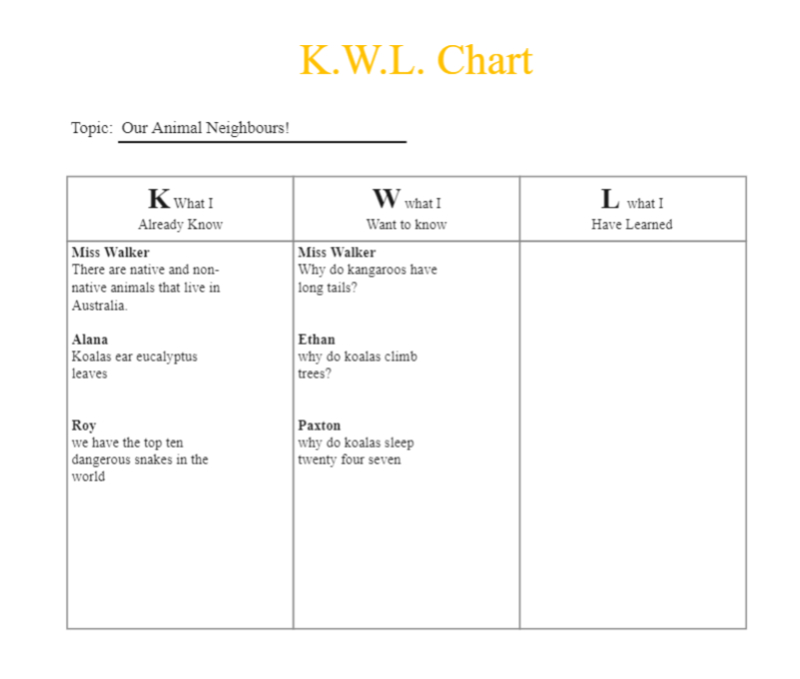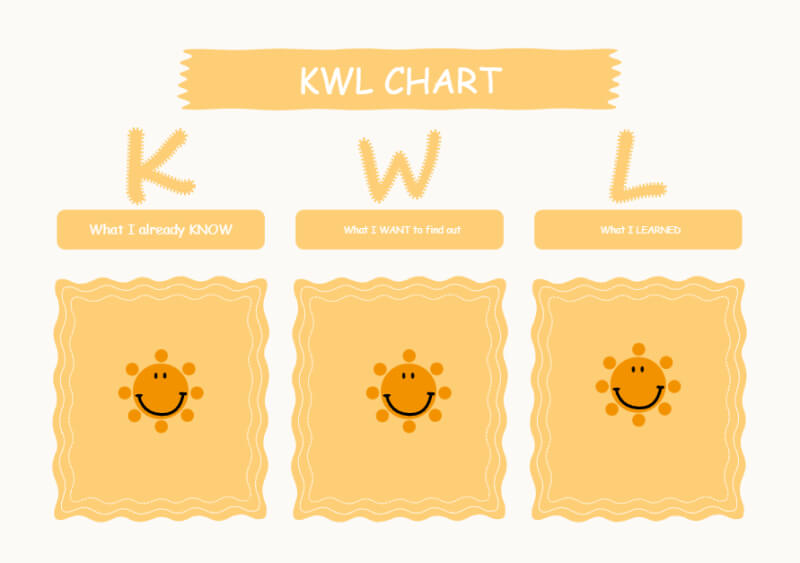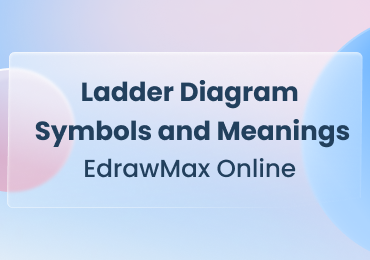What Is KWL Chart?
KWL chart is an excellent learning tool for students because it improves their comprehension of the topic. Having students engage in creative learning activities with KWL charts helps them easily understand any topic and makes them interested in learning. Here, you can learn everything you want to know about KWL charts, their benefits, and how to use them.
1. What is a KWL Chart?
A KWL chart is a simple and effective learning tool that helps students share their ideas and prior knowledge about a particular topic, comprehend new lessons, and give feedback about what they learned. KWL is an acronym for (K)what I know, (W)what I want to know, (L)what I learned. Students write what they already know and wish to learn before learning a new topic. After they finish learning the topic, they write about their lesson.
Teachers use KWL charts to engage their students in learning new topics with interest. With these charts, students feel like they are in charge of their own learning, which helps them comprehend lessons quickly. After all, they are learning new topics because they want to. KWL chart templates are commonly used in multiple teaching activities because teachers can understand students' knowledge gaps and focus on teaching those things they want to learn. With these charts, students can track their own improvement by comparing what they knew before learning any topic and their understanding after learning it.

Click on the image to edit. Source: EdrawMax Online
2. Benefits of Using KWL Chart
Engaging students in creative learning with KWL charts help them easily understand any topic and increase their interest in learning new things. Teachers use these charts because students love to do creative activities, motivating them to learn more. With these charts, students become in charge of their learning because they learn those topics they want to learn, not something that doesn't interest them.
Encourages students to brainstorm the topic and write what they think about it. Using KWL charts to direct any student's learning is simple and effective. The best part about using KWL charts is that students can write what they think about the topic, not what the teacher wants them to think. It also adds flexibility to what they are learning and improve their comprehension.
KWL charts are easy to use as there is no technique involved; students only write whatever they think. Before learning any topic, teachers give students the title and ask them what they know about it. It helps the teacher understand the knowledge gap of students. The students complete the three columns in the chart while learning a new topic.
Effective tool for notetaking and tracking learning progress. KWL charts help teachers track multiple learning stages of a student. In the introduction stage, students write their prior knowledge about the topic they are about to learn. After getting the introduction, they note the details they think are important and let the teacher know what interests them.
3. KWL Chart Use Cases
Introducing New Topic: Teachers use KWL charts to introduce new topics to their students. Using a creative KWL chart before starting a new topic is helpful because it develops students' interest instead of starting a lesson with boring text reading. It is also useful to the teachers because it helps them better understand their students, such as their knowledge gaps and interests. Teachers show book or topic title to the students and ask them what they think this title is about.
Track Student's Learning: KWL charts are creative learning tools for students that motivates them to engage in learning, and for the teachers, it is an excellent teaching and tracking tool that helps them keep track of their student's learning. Students tell their teachers what they know about the topic before learning it; they also share what they want to learn from any new topic. After learning the topic, teachers monitor their improvement after comparing their prior knowledge to their understanding.
Generating new Ideas: You can also use KWL charts as thinking tools because it helps students communicate their ideas and thoughts about the new topic they will be learning. After reading the title the students come up with ideas and gather information about it. After that, they also brainstorm to write what they want to learn.
Recall Prior Knowledge: Students use KWL charts for test preparations and making assignments. When they start their test preparations, they create a KWL chart to organize information to determine what topics they don't need to learn and what they never learned in the syllabus. It helps them study smartly by giving more time to prepare things instead of wasting equal time studying everything.
Watch this video to learn more about graphic organizer. If the video doesn't play, please visit it at YouTube.
4. How to Use KWL Chart?
Before you create and use KWL charts, it is better to understand what is a KWL chart. Knowing the layout and benefits of a graphic organizers makes using it much easier. Follow these steps to use a KWL chart.
Make a KWL chart
You can use KWL chart templates to create your chart to use it. You can also make it from scratch, but it will take time and effort. Use EdrawMax Online to get professional templates and create your chart in a few clicks.
Complete 1st Column (K)
After you make a KWL chart, the first step is to complete the K column, where you will ask your students to write everything they know about the topic before learning it. The k stands for what the students know. Teachers give the topic title or show the book cover to their students and ask them about their thought regarding that title. It helps students recall prior knowledge and write everything they know about it.
Complete 2nd Column (W)
The second step is to complete the W column. Here students write about their interests and what they want to learn from the new topic. KWL charts empower students by making them in charge of their own learning. Once they read the title and write what they already know about it, they share what they wish to learn from the topic. It can be anything such as the book ends, the main lesson, or anything related to the topic.
Complete 3rd Column (L)
The final step is to complete the L column. This step comes after the teachers explain the topic and ask their students what new things they learned from it. It also helps them track their improvement by comparing their thoughts about what I know they wrote before learning the topic and their feedback. The students share their understanding in the 3rd column of the KWL chart.
5. KWL Chart Examples in Education
There are various layouts of KWL charts that are commonly used in education. KWL chart examples give you a clear understanding of the types and uses of these charts for various topics and subjects. Engaging in creative activities help students focus and learn new topics every day. KWL charts can easily recall their prior understanding before learning something new and their knowledge after learning the new topic. It helps them realize their improvement because they are in charge of their learning outcome. Here are some KWL chart templates and examples.
Example 1: KWL Chart PDF
This is a KWL chart PDF example that educators use to get input from all the students before and after teaching new lessons or topics. The topic title can be anything from book titles to nouns. In the first section, those students who know a few things about today's topic share their information. The second section is students asking various questions about that topic. After learning about that topic for the third section, students will write about what they understood.

Example 2: Science KWL chart
This science KWL chart help educators teach new lessons to their students. Students can share their prior knowledge about the topic they are will learn in the what I already know column. They ask questions and write about what they want to learn in the 2nd column. After learning the topic, they can compare their understanding with other students. Teachers monitor the improvement of their students by asking them to complete the what I learned column.

Example 3: KWL chart Printable
The KWL chart printable is an excellent tool for introducing new science concepts to the students. A printable template helps out a lot because teachers can go to a diagramming software, get a template and print it as it is instead of wasting time and creating one from scratch on a piece of paper. The KWL chart in this example can be about anything related to the topic. It is a learning chart for kids.

6. FAQ About KWL Chart
1. How do you do a KWL activity?
You can do a KWL activity with a KWL chart. There are three columns in a standard KWL chart. Give the topic name or title at the top. In the first column, write your prior knowledge about that topic. Write what you want to learn from that topic in the second column. In the third column, write your understanding of the topic after learning it.
2. Can you list a KWL chart lesson plan?
KWL charts are graphic organizers that students use to share their ideas and prior understanding of any lesson or topic. In a KWL chart lesson plan, students write what they think about the topic before learning it. They tell the teacher what they want to learn or ask various questions while learning it. After learning it, they give feedback and write their understanding of the topic to represent their improvement.
3. How to make a KWL chart?
You can visit EdrawMax Online and create a KWL chart with its professional templates and symbol library. EdrawMax is the best KWL chart maker that gives you many customization tools and other amazing features such as importing symbols making presentations. It also supports various document formats. Start by picking a template and editing it on EdrawMax. Complete the columns and finish your KWL chart.
7. Key Takeaways
The KWL chart is a creative and effective learning tool that engages students in learning new topics and improve their comprehension. Students use these charts at three stages of learning a new topic. They share their prior knowledge before learning, write what they want to learn during that topic, and show their understanding after learning the topic. KWL charts are easy to use, and you can easily create these charts using templates on EdrawMax Online. Find more KWL examples.










